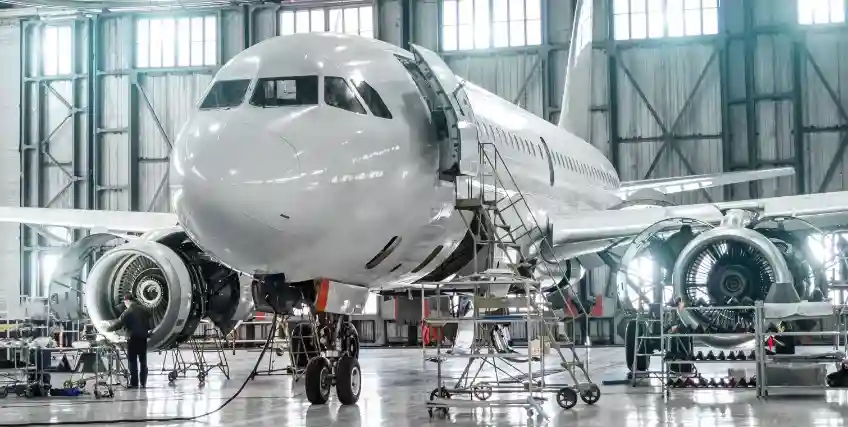Working Capital Loans for Aviation Maintenance and Operations
July 08, 2025 | Last Updated on: July 14, 2025

In the aviation industry, safety, efficiency, and reliability are paramount. But behind every safe takeout and landing is a list of operational demands, maintenance costs, and regulatory timelines that businesses must meet for success. Whether you're running a charter jet service, flight school, cargo operation, or maintenance facility, having consistent and reliable access to working capital can be the difference between staying grounded or soaring ahead of the competition.
Here's a look at how Working capital loans can support aviation businesses, from covering maintenance and unexpected repairs to providing the funds necessary for payroll and compliance. This can help you choose between some of the best aircraft financing options, no matter your business needs.
Why Aviation Businesses Require Financing
Businesses in the aviation industry face unique challenges compared to other industries. They’re also no stranger to significant (sometimes astronomical) upfront costs and cash flow inconsistencies, making it harder to juggle financing needs and keep things moving along.
You can understand how important general aviation financing is when you consider the ongoing financial challenges of this industry.
- Whether you’re buying business jets or private aircraft, the loan amount required for aircraft purchases can be incredibly high.
- Scheduled maintenance, inspections, and unexpected repairs are a necessary part of aircraft ownership and come with high ongoing costs.
- Payroll expenses are generally higher in the aircraft industry than many others, as paying for pilots, mechanics, and ground crew on staff is non-stop.
- Daily operating costs for aircraft businesses include fuel, aviation insurance, plane maintenance, and hangar fees.
- Seasonal demands, delayed client payments, and unexpected maintenance issues can lead to cash flow volatility.
Working capital loans provide a financial cushion that keeps operations running smoothly. Rather than delaying critical repairs or cutting staff, these loans help aviation businesses stay compliant and competitive.
Common Uses for Aviation Loans
No matter the size of your aviation business, the best aircraft financing options can help you meet any number of funding needs. Some of the most common ways aviation business and aircraft owners can use these loans include:
- MRO (Maintenance, Repair, and Overhaul)
- Paying for parts and equipment
- Covering staffing expenses and payroll
- Making facility upgrades
- Buying inventory and supplies
- Covering fuel costs
- Bridge financing
- Meeting regulatory requirements
The funds from the best aircraft financing loans will help your company maintain operational integrity and reduce downtime. Both are essential in an industry where delays and cancellations are costly and can damage your reputation.
Types of Loans Available Through Airplane Finance Companies
The right business and aircraft loan for your aviation company depends on how you plan to use the money, how much you need to borrow, and what you can afford to repay. Loan rates and repayment terms will vary based on the aircraft financing option you choose, but here’s a look at some of the most common.
Working capital loans
Working capital loans provide your business with a lump sum that’s then repaid over a set term. They're ideal for short-term expenses like repairs or temporary payroll needs and can either be secured by collateral or unsecured.
Secured working capital loans may offer more competitive rates since they use assets like aircraft or equipment as collateral to secure the debt. That said, unsecured loans may be a better option for newer businesses without many assets.
Business line of credit
A business line of credit is a revolving debt similar to a credit card; once this line of credit is approved and opened, you can pull from it as needed without going through a new application process or waiting for loan pre-approval.
Existing business lines of credit are perfect for covering intermittent costs like fuel, emergency maintenance or repairs, and unexpected staffing needs. You’ll have access to cash on the spot without having to find the right lender or wait for approval, and only pay interest on the amount you draw.
Equipment financing
Aviation businesses may need to finance certain equipment, especially those that come with a high purchase price. For example, ground support equipment may not need to be replaced often, but can easily run into the hundreds of thousands of dollars (or more) the first time you buy it.
Your business will also need diagnostic and repair tools to keep aircraft running. Avionics and cabin systems help keep your fleet safe, comfortable, and up-to-date, but come with a high price tag.
Equipment financing loans are asset-backed, meaning the item(s) you purchase will be used to secure the debt. These loans are often offered by niche companies and aircraft financing programs familiar with aviation needs.
SBA loans
Loans backed by the Small Business Administration (SBA) can help aviation businesses get the funding they need for support, growth, or acquisition. For example, the SBA 7(a) or SBA 504 loans give up to $5 million to eligible aircraft maintenance companies, charter services, or fixed-base operators (FBOs), whether you want to buy a new single-engine Cessna or build a new facility.
SBA loans offer low fixed rates and long amortization terms that can make them one of the best aircraft financing options for small businesses. However, they also require substantial documentation, a comprehensive application, a loan down payment, and a lengthy approval time, making them a less popular option for newer aviation business or those needing funds quickly.
Asset-based lending
If you own valuable aircraft, tools, or inventory, you can use those assets as collateral to secure larger loans. You may even be able to refinance them to unlock funds in some cases. Asset-based lending can be valuable for businesses with high-value holdings but uneven cash flow.
Invoice factoring
Many clients pay invoices on net-30, net-60, or even net-90 terms, which is especially common for aviation businesses working with government contracts or corporate clients. This means that your aviation company could be stuck waiting for funds that will eventually come, but may take months to arrive, straining cash flow in the meantime.
If your business is in this situation, one of your best aircraft financing options might be invoice factoring.
What Lenders Look for in Aviation Financing Applicants
To qualify for aviation loans, lenders typically evaluate a number of business factors. This includes looking at your years in operation and revenue history; more established businesses with a track record of profitability (or steady growth) may receive better terms. The aircraft and assets you own and plan to buy also matter, including the type age, and value.
Your business’s maintenance and compliance records will help demonstrate regulatory reliability, while your cash flow statements give lenders the assurance that you’re able to repay the debt. Lastly, your business — and sometimes your personal — credit may be considered, showing your experience managing large loans and paying debt as promised.
Expect that the best aircraft financing lenders will ask for key pieces of documentation as part of the application process. This includes things like your business licenses, previous years’ tax returns (personal and business, depending on the situation), FAA registrations, profit and loss statements (P&Ls), and aircraft valuation reports.
How to Choose Some of the Best Aircraft Financing Option
Not all loans or lenders are created equal. So how do you choose some of the best aircraft financing lenders and loan for your specific situation? Asking yourself a few specific questions can help.
- What is the purpose of this loan? Match the loan type to your business goal. Need new diagnostic equipment or want to buy experimental aircraft? Look at equipment financing. Facing a short-term cash crunch that might keep you from making payroll? Consider a working capital loan, line of credit, or invoice factoring.
- Does the lender have industry experience? Prioritize loans through aviation finance companies that understand FAA regulations, aircraft lifecycles, and compliance standards. These are the best aircraft financing (and refinancing) choices for many aviation businesses.
- What are the loan terms and options, and how flexible are they? Look beyond interest rates and be sure to consider origination fees, repayment schedule, prepayment penalties, and renewal terms. Also, some lenders offer seasonal payment structures or deferred payments based on business cycles, which may be helpful if you’re ever in a rut.
- How fast can I get funding? Online aviation lenders may approve loans in just days, while SBA loans can take weeks to get approved and funded. Make sure your aircraft loan matches your funding needs.
Some of the best aircraft finance companies often specialize in general aviation financing and offer personalized terms for operators, MRO providers, and FBOs. To better understand what you need, what you can afford, and which lender has what you need, consider using a loan calculator.
Final Thoughts
Whether you're managing daily MRO operations or prepping your turboprop fleet for high-demand seasons, having access to smart capital is essential in the aviation industry. Working capital loans help cover the often unpredictable, but always essential, expenses that keep aircraft flying and businesses profitable. Choosing the best aircraft financing means partnering with lenders who understand your industry, offer flexible loan structures, and provide fast, reliable funding to keep you off the ground.
FAQs on Some of the Best Aircraft Financing
How do aviation finance companies differ from traditional lenders?
Some of the best aircraft financing companies specialize in general aviation financing. They understand industry-specific needs, FAA regulations, aircraft value assessments, and seasonal cash flow challenges, offering more tailored loan terms and underwriting.
Can a new aviation business qualify for a loan?
It may be more challenging, especially if you’re shopping with one of the best aircraft financing companies. Startups may qualify for unsecured working capital loans, equipment financing, or microloans from the SBA, though these are usually smaller loans and may have higher interest rates. Providing a strong business plan and collateral can help strengthen your application.
What do I need to apply for an aviation loan?
As part of the application process, the best aircraft financing companies will typically ask you to provide your FAA registrations, aircraft valuations, P&L statements, business tax returns, licenses, and proof of compliance or maintenance history.
What’s the difference between equipment financing and a working capital loan?
Equipment financing can be used specifically to purchase aircraft tools, avionics, or ground support gear, as the loan is secured by the item as collateral. A working capital loan, on the other hand, is more flexible and usually unsecured, so it can be used for various short-term needs.
Do aviation businesses qualify for SBA loans?
Charter operators, MRO shops, and FBOs may qualify for SBA 7(a) or 504 loans, which offer lower interest rates and longer repayment terms. This makes them ideal for business expansion or facility upgrades. If you’d prefer faster funding or don’t qualify for an SBA loan, consider shopping for a niche business loan through one of the best aircraft financing companies.




